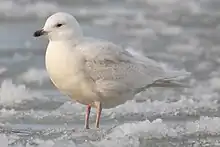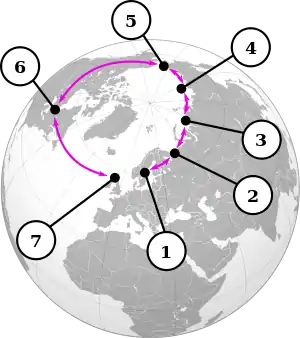| Larus | |
|---|---|
 | |
| European herring gull (Larus argentatus) | |
| Scientific classification | |
| Domain: | Eukaryota |
| Kingdom: | Animalia |
| Phylum: | Chordata |
| Class: | Aves |
| Order: | Charadriiformes |
| Family: | Laridae |
| Subfamily: | Larinae |
| Genus: | Larus Linnaeus, 1758 |
| Type species | |
| Larus marinus Linnaeus, 1758 | |
| Species | |
|
See list | |
Larus is a large genus of gulls with worldwide distribution (by far the greatest species diversity is in the Northern Hemisphere).
Many of its species are abundant and well-known birds in their ranges. Until about 2005–2007, most gulls were placed in this genus, but this arrangement is now known to be polyphyletic, leading to the resurrection of the genera Ichthyaetus, Chroicocephalus, Leucophaeus, and Hydrocoloeus (this last had been recognized more often than the other genera) for several species traditionally included in Larus.
They are in general medium to large birds, typically grey or white, often with black markings on their heads or wings. They have stout, longish bills and webbed feet.
The taxonomy of the large gulls in the herring and lesser black-backed complex is very complicated, with different authorities recognising between two and eight species.
Taxonomy
The genus Larus was introduced in 1758 by the Swedish naturalist Carl Linnaeus in the tenth edition of his Systema Naturae.[1] The genus name is from Ancient Greek laros (λάῥος) or Latin larus, which appears to have referred to a gull or other large seabird.[2] The type species is the great black-backed gull (Larus marinus).[3][4]
Species
The genus contains 25 extant species.[5]
| Image | Common Name | Scientific name | Distribution |
|---|---|---|---|
 | Pacific gull | L. pacificus | Australia. |
 | Belcher's gull | L. belcheri | the Pacific coast of South America. |
 | Olrog's gull | L. atlanticus | Atlantic coast of southern Brazil, Uruguay, and northern Argentina. |
 | Black-tailed gull | L. crassirostris | coastlines of the East China Sea, Japan, Manchuria and the Kuril Islands, to Alaska and North America |
 | Heermann's gull | L. heermanni | the United States, Mexico and extreme southwestern British Columbia |
 | Common gull or mew gull | L. canus | the Palearctic, northern Europe |
 | Short-billed gull | L. brachyrhynchus | northwestern North America |
 | Ring-billed gull | L. delawarensis | Canada and the northern United States |
 | California gull | L. californicus | western North America from the Northwest Territories, Canada south to eastern California and Colorado. |
 | Great black-backed gull | L. marinus | European and North American coasts and islands of the North Atlantic |
_-Hot_Water_Beach_-NZ-8.jpg.webp) | Kelp gull (called southern black-backed gull or karoro in New Zealand) | L. dominicanus | South America, parts of Australia, and New Zealand |
 | Glaucous-winged gull | L. glaucescens | western coast of Alaska to the coast of Washington, coast of California, Oregon, Baja California, Baja California Sur, and Sonora |
%252C_Point_Lobos%252C_CA%252C_US_-_May_2013.jpg.webp) | Western gull | L. occidentalis | from British Columbia, Canada to Baja California, Mexico. |
 | Yellow-footed gull | L. livens | Gulf of California in Mexico |
.jpg.webp) | Glaucous gull | L. hyperboreus | North Atlantic and North Pacific Oceans as far south as the British Isles and northernmost states of the United States, also on the Great Lakes. |
 | Iceland gull | L. glaucoides | Canada and Greenland |
 | European herring gull | L. argentatus | shores of Western Europe |
 | American herring gull | L. smithsonianus | North America from central and southern Alaska to the Great Lakes and north-east coast of the United States from Maine south to North Carolina. |
 | Yellow-legged gull | L. michahellis | Mediterranean Sea. |
.jpg.webp) | Caspian gull | L. cachinnans | Black and Caspian Seas, extending eastwards across Central Asia to north-west China. |
_Gambell%252C_Ak_-03_(2844589388).jpg.webp) | Vega gull (or East Siberian gull) | L. vegae | northeastern Siberia and winter in Japan, Korea, southern and eastern China, and Taiwan. |
 | Armenian gull | L. armenicus | the Caucasus and the Middle East |
 | Slaty-backed gull | L. schistisagus | the north-eastern coast of the Palearctic |
 | Lesser black-backed gull | L. fuscus | Atlantic coasts of Europe |
 |
White-eyed gull | L. leucophthalmus | Siyal Islands, in the Red Sea |
Fossils
Fossils of Larus gulls are known from the Middle Miocene, about 20-15 million years ago; allocation of earlier fossils to this genus is generally rejected. Biogeography of the fossil record suggests that the genus evolved in the northern Atlantic and spread globally during the Pliocene, when species diversity seems to have been highest, as with most seabirds.
- Larus sp. (Middle Miocene of Grund, Austria)
- Larus sp. (Middle Miocene of Romania) [6]
- Larus sp. (Late? Miocene/Early Pliocene of Lee Creek Mine, U.S.) - several species [6]
- Larus elmorei (Middle Pliocene of Bone Valley, southeastern U.S.)
- Larus lacus (Late Pliocene of Pinecrest, southeastern U.S.)
- Larus perpetuus (Pliocene of southeastern U.S.)
- Larus sp. (San Diego Late Pliocene of the southwestern U.S.)
- Larus oregonus (Late Pliocene - Late Pleistocene of the west-central U.S.)
- Larus robustus (Late Pliocene - Late Pleistocene of the west-central U.S.)
- Larus sp. (Late Pleistocene of Lake Manix western U.S.)
"Larus" raemdonckii (Early Oligocene of Belgium) is now at least tentatively believed to belong in the procellariiform genus Puffinus. "L." elegans (Late Oligocene?/Early Miocene of St-Gérand-le-Puy, France) and "L." totanoides (Late Oligocene?/Early Miocene of southeastern France) are now in Laricola, while "L." dolnicensis (Early Miocene of the Czech Republic) was actually a pratincole; it is now placed in Mioglareola.
The Early Miocene "Larus" desnoyersii (southeastern France) and "L." pristinus (John Day Formation, Willow Creek, U.S.) probably do not belong in this genus; the former may be a skua.[7]
Ring species

sensu strictoThe circumpolar group of Larus gull species has often been cited as a classic example of the ring species. The range of these gulls forms a ring around the North Pole. The European herring gull, which lives primarily in Great Britain and Northern Europe, can hybridize with the American herring gull (living in North America), which can also interbreed with the Vega or East Siberian gull, the western subspecies of which, Birula's gull, can hybridize with Heuglin's gull which, in turn, can interbreed with the Siberian lesser black-backed gull (all four of these live across the north of Siberia). The last is the eastern representative of the lesser black-backed gulls back in northwestern Europe, including Great Britain. However, the lesser black-backed gulls and herring gull are sufficiently different that they rarely interbreed; thus, the group of gulls forms a continuum except in Europe, where the two lineages meet. However, a recent genetic study has shown that this example is far more complicated than presented here, and probably does not constitute a true ring species.[8]
See also
References
- ↑ Linnaeus, Carl (1758). Systema Naturae per regna tria naturae, secundum classes, ordines, genera, species, cum characteribus, differentiis, synonymis, locis (in Latin). Vol. 1 (10th ed.). Holmiae (Stockholm): Laurentii Salvii. p. 136.
- ↑ Jobling, James A (2010). The Helm Dictionary of Scientific Bird Names. London: Christopher Helm. p. 219. ISBN 978-1-4081-2501-4.
- ↑ Selby, Prideaux John (1840). A Catalogue of the Generic and Sub-Generic Types of the Class Aves, Birds, Arranged According to the Natural System. Newcastle: T. and J. Hodgson. pp. 48–49.
- ↑ Peters, James Lee, ed. (1934). Check-List of Birds of the World. Vol. 2. Cambridge, Massachusetts: Harvard University Press. p. 313.
- ↑ Gill, Frank; Donsker, David; Rasmussen, Pamela, eds. (July 2021). "Noddies, gulls, terns, skimmers, skuas, auks". IOC World Bird List Version 11.2. International Ornithologists' Union. Retrieved 16 August 2021.
- 1 2 Olson, Storrs L. (1985): Section X.D.2.j. Laridae. In: Farner, D.S.; King, J.R. & Parkes, Kenneth C. (eds.): Avian Biology 8: 181-182. Academic Press, New York.
- ↑ (Olson, 1985).
- ↑ Liebers, Dorit; de Knijff, Peter & Helbig, Andreas J. (2004). "The herring gull complex is not a ring species". Proc. R. Soc. B. 271 (#1542): 893–901. doi:10.1098/rspb.2004.2679. PMC 1691675. PMID 15255043.Supplemental material: Electronic appendices
_svg-element.svg.png.webp)

